I thought I was a strong swimmer. But I was also seventeen, and I thought I knew everything.
It was hot, and the Delaware River was refreshingly cool. I can do this, I said to myself, perhaps a little too confidently. I stood at the bank of the Pennsylvania side, with my eye on a small sandy landing across the river in New Jersey. I jumped in and made it across easily, then without really thinking about it I quickly turned around and swam back.
Halfway back, I learned quickly that I wasn’t as strong of a swimmer as I thought, and that I should have given myself more time to rest before attempting the trip back. I was caught in the current, and started to move sideways instead of across. Foolishly I tried to fight it; tried to swim against the current and, as I started to drift downstream, I quickly tired myself out.
I felt myself losing the battle, and allowed the current to carry me for a while. I struggled to stay afloat, felt myself starting to drown, found myself reflecting in that panicked moment how this is never what it looks like on TV or in the movies, all while still facing upstream and still attempting to swim back the way I came. I tried floating on my back but the river kept pulling me down. Knowing that there wasn’t a human in sight that could hear a scream for help, I started shouting the names of every deity I could think of at that moment, but yelling for only those few seconds quickly weakened me further. I switched from screams to silent thoughts as I felt I was about to go under, my last concern being that I didn’t tell anyone I was even going for a swim in the first place.
And then I literally smacked into a ton of bricks. I had been facing upstream the entire time, and in all my struggling I didn’t notice that there was a bridge behind me. I landed on a masonry pier, and the height of the water was at an exact level that I found myself seated on the ledge of the pier before I even realized where I was. The moment I was about to go under, the bridge had provided a chair for me to rest.
I sat there for the next few hours, first to catch my breath, then to reflect. I had done a very foolish thing, and I nearly paid with my life. I owed that life to what I would have always considered to be an inanimate object … until that moment of collision. There was something so alive about the pier; the way an old tree or the river itself felt alive. And the longer I sat there on the edge of the pier, in a strange dazed delirium filled with fear and gratitude, the more I felt a very deep connection with stones themselves, even more so than I had every felt from a tree or a river. There was a true mutual appreciation in that moment: I appreciated the pier for being where it was, and the pier seemed to appreciate my just sitting on it for a few hours in contemplation. I thought about the people who constructed that pier, each brick laid down by hand, the literal sweat and blood that went into this structure that held me in a time of need.
When I felt rested and clear-headed enough, I prepared to swim back to the riverbank. I found myself thanking the pier profusely, at that point having the same regard for its spirit and sentience as I would any person or animal, and right before I jumped back in the river I asked the pier to wish me luck and if possible to see me over to the other side. The swim back was easy, and by the time I landed on the riverbank the only pain I felt was a bruise on my side from when I had smacked into the pier.
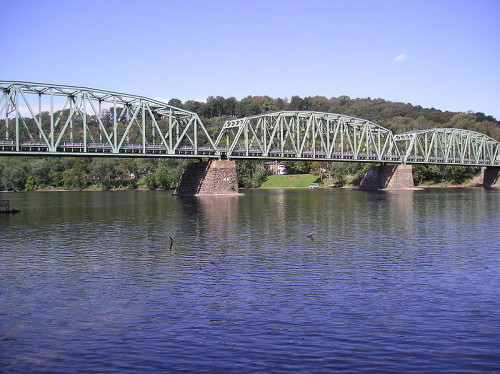
The bridge that caught me. [Photo Credit: Aerolin55]
That pier had life; that pier had spirit. That pier had imprinted something unshakable upon me.
* * *
It may be painfully typical to state that such an experience dramatically shifts one’s perspective on life, but it’s the only way to describe the transformation that I went through in the months after the bridge incident. Not only was I grateful for and deliberate in my existence in a way that I couldn’t have imagined beforehand, but I became fascinated by and fixated on both spirits and bridges in various ways.
After spending a few months processing what happened at the bridge, I left home and started to couch-surf with friends in New York City, first in lower Manhattan and then in Brooklyn. At first, I took with me only my backpack and a small bag of possessions that most would consider mere knick-knacks but I saw as infused with consciousness and spirit. Among those possessions was a small piece of moss that I had pulled off the masonry pier.
I loved so much about Brooklyn, but I loved the bridges the most. I found myself mesmerized by the bridges; first by their structures themselves and then by the lush history behind their existence. I spent hours in the library, drinking in stories of the building of the Brooklyn Bridge, and later the Verrazano.
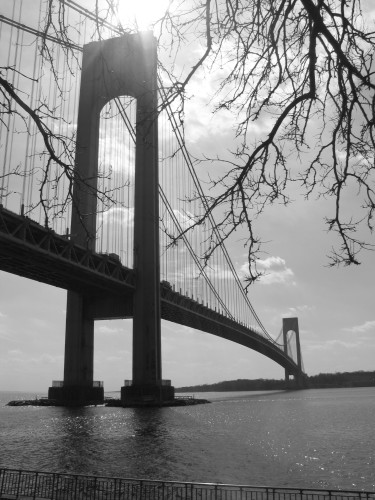
Verrazano Bridge from Bay Ridge, Brooklyn. [Photo by A. Valkyrie.]
I loved and appreciated those bridges, but did I ever shutter deep down whenever I thought of the true cost, whenever I consider the ghosts of a generation uprooted.
* * *
Nearly a decade after the bridge incident, I packed my things and moved across the country. I didn’t have time to say goodbye to that bridge when I left, but I kept it in my thoughts and my prayers as I was saying goodbye to the East Coast, to Brooklyn, to the bridges that I had adopted as my own in the years that I was a resident of New York City. I took only what I could carry in my van with the front area behind my seat reserved for carefully-packed boxes containing, what I then referred to as, ‘spirit-items’.
On day five in the car, driving along the Columbia Gorge in Oregon less than an hour from Portland. I suddenly saw a sign. Bridge of the Gods, it said.
I turned off at the exit.
The bridge looked rather modern, almost disappointingly so, but a historical plaque told an intriguing story about an ancient bridge that once stood in that spot. There was a natural land-bridge that once blocked the river, that was the subject of various folkloric tales from indigenous tribes that populated the area prior to European settlement.
There was something about stumbling upon local mythology, around gods and bridges, so close to the end of my journey to a new home that struck me in a very significant way.
I walked down to the base of bridge, going as far down the steep riverbank as I safely could manage. I introduced myself, and left a few coins at the base. Despite its newness, despite its lack of any real connection to the historic ‘Bridge of the Gods’, there was something about it that still felt sacred.
Walking back up, a rock the size of a golf ball bounced down straight towards me. I stopped it with my foot, picked it up, and put it in my bag. I slipped it into the special box right behind the front seat.
Eight years ago, eight moves ago.
* * *
“Hey, would you mind holding onto Grandpa for me? I really don’t have a safe place for him and … well … you’ve already got a big collection of dead things that you take care of …”
‘Grandpa’ was a jar of ashes; more specifically the ashes of my ex’s grandfather who had passed over during the first year of our relationship. Grandpa had indeed found a comfortable spot among my various collections of dead things over the course of our relationship.
We were at the point in the break-up process in which we were dividing our things in preparation for his move back to the Midwest, and I was deliberately forcing a mindset of collaboration and compassion in order to maintain my sanity. I had already been keeping an eye on Grandpa as though he were my responsibility. It seems sensible to maintain what was already routine for me.
“Of course, don’t worry.” I replied. “Leave Grandpa right where he is, I’ll keep an eye on him.”
Five years ago, five moves ago.
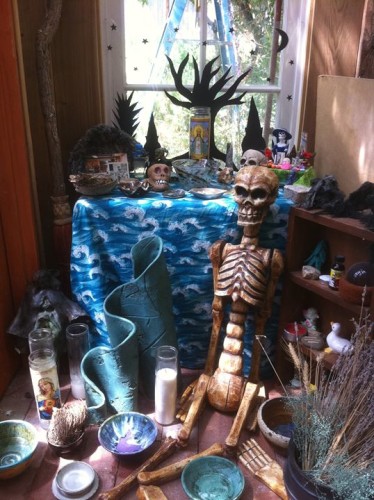
The Patio of Living Things, circa 2010. ‘Grandpa’ is hidden in the corner behind the lavender. [Photo: A. Valkyrie]
* * *
I knew he was severely depressed to the point where he was possibly suicidal, and I knew that a change of environment can often positively shift someone that is in such a state. It was only a few days after I started scheming on how to get him out here that a thousand dollars literally dropped into my lap unexpectedly in a way that only happens when greater forces are at work. I bought him a plane ticket from upstate New York to Eugene and, a few weeks later, we were headed down the 101 in my van, packed for camping and exploring.
We drove for ten days, down from Florence, Oregon all the way to Mendocino and back, stopping at every place that looked interesting and many other places that were simply quiet and serene. We camped in the redwoods, on the coast, on the bank of the Russian River. He ran right in, I timidly waded up to my knees and stood in contemplation. I took a few steps more but wouldn’t go in past my waist.
He asked why, I told him. “Once bitten, twice shy,” I said when I finished the story.
He nodded. We shared many other stories that week, of close calls and near-death experiences, as well as darker experiences such as self-harm and suicide. He admitted to me that he had contemplated killing himself, both in the past and very recently. I nodded; I had sensed as much. I didn’t have to say aloud that such worries were why I flew him out here … it was unspoken but understood.
By the time we got back to Eugene, the van was filled with various objects, both natural and man-made, that we had amassed over the course of our trip. He had the same sense and affinity for what he called ‘living’ objects as I did. Much of our trip consisted of stumbling upon such wonders like small children, giggling as we left offerings in return.
As he packed up to return to New York, we both tried in vain to fit the entirety of his new collection in his baggage, cramming nearly everything except for a pile of bark and a bag of meticulously chosen and extremely ‘living’ bunch of sticks that he had intended to carve an ogham set with.
“I have to leave that all here. You can have the bark,” he said. “But I would love that bag of sticks back from you one day.”
“I’ll give them back to you the next time I see you,” I replied.
Four years ago, four moves ago.
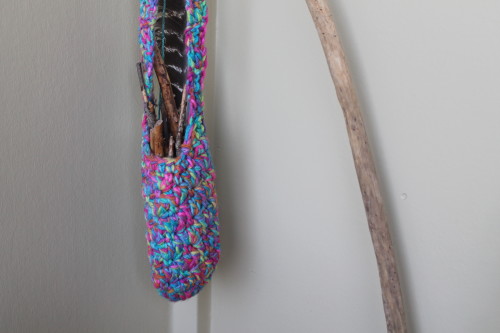
[Photo: A. Valkyrie]
I called her to confirm what I already knew and subsequently broke down for several hours. At one point, I looked over at the bag of sticks, hanging on the door, and remembered my words to him.
“I’m still going to hold onto your sticks until I see you again,” I said aloud.
A few days later, I placed them with the rest of the collection.
* * *
When I knew I had to leave Eugene, I surrendered my fate to the Gods, who very quickly and bluntly guided me to a tiny little studio, 100 yards from the river, smack dab between two of Portland’s most iconic bridges. I didn’t even begin to question it, I simply accepted it and settled in.
The tone had been instantly set for my Work in this new place, and the very first action I took even before signing the least was to make offerings at the bases of both bridges. I thanked the bridges for their presence and their function, I made prayers and offerings to those who were sacrificed in the construction of the bridge, and to those who had taken their lives by jumping. I also made prayers and offerings for those who currently lived under the bridges, those who we tend to label as ‘homeless’ and ‘mentally ill’ and ‘addicts.’
The studio was just under 400 square feet. Realizing that there was not enough room to unpack the majority of my possessions, within a few months I put myself on a waiting list for a bigger space in the same building, unheeded by the warning from management that it could take well over a year to happen. The studio served an immediate purpose in terms of survival and a place to print, but was unsuitable as a place of worship or Work. I took my worship and Work to the riverbank, to the bridges, building altars on abandoned piers and stone foundations.
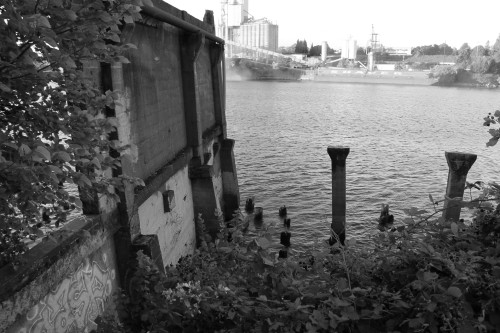
[Photo Credit: A. Valkyrie]
One year ago, one move ago.
There’s something admittedly strange and yet comforting in talking to boxes, feeding them and caring for them just as you would were they outside of the box. I kept an eye on them, checked up on them constantly, awaiting the day when I would be able to unpack them again and put them in their proper places.
* * *
There have been well over 200 drownings in Oregon in the past decade The vast majority of them occurring in rivers in the Willamette Valley.
I don’t have the luxury of believing in coincidence, so it only seemed perfectly natural that I stumbled across a detailed list of those drownings the same day that my computer screen was filled with headlines and opinions focused on the racial dynamics of a pool-party incident in Texas. Browsing the list of drownings, it struck me immediately that a significant number of those who have drowned in Oregon were people of color, in a state that is overwhelmingly white.
In a vastly unequal society where minorities and the poor were both historically and still presently denied access to safe, publicly accessible bodies of water, it sadly makes sense that so many would seek to relieve themselves from the heat in the rivers, and meet a tragic fate in doing so. Learning how to swim, learning what to do when one is in danger of drowning, and being able to safely access bodies of water when it is hot, are basic needs in terms of public safety that should be accessible to anyone and everyone in this country, regardless of race, socioeconomics, or documented status.
I read through the list again, this time focusing on the descriptions of the incidents. It hit a tender nerve when I read through accounts of drownings that resulted from those who thought that they could swim across a river. It has been more than fifteen years since I nearly drowned, but after having relived the incident more times in my mind than I ever care to acknowledge, the naivete and commonality of my mistake still reverberates. I thought I was a strong swimmer, I still cling to occasionally in defense. I thought I was a strong swimmer.
But there’s a piece of moss on my altar that will always remind me otherwise.
With those thoughts swirling through my mind, I went down to the base of the nearest bridge, as close to the water as I could get, with flowers for those who have died in the river. I petitioned the bridge and the land spirits to do what they could to protect those who may be floating by in distress. I spent a moment in touch with my inner terror, that taste of death that has never quite left me since my own dip in the river years before, and I whispered prayers of protection towards the opposite side as I let that terror go on the riverbank.
* * *
It has been unbearably hot this past week, as my partner and I moved boxes from the tiny studio to a larger space in the same building, after nearly a year of waiting for such a space to open up. The new place faces the river just across the street, and the breeze from the Willamette blows directly into my new living-room and bedroom. It’s at least fifteen degrees cooler than the studio, which faced southward with very little breeze.
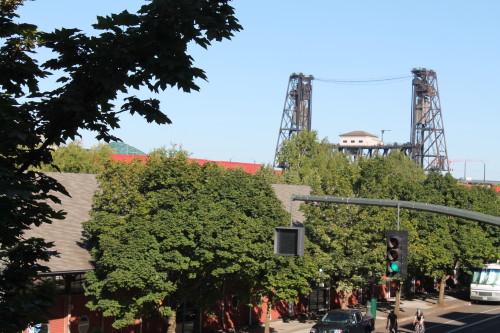
[Photo Credit: A. Valkyrie]
Now. Here.
A hundred yards from the river, between two bridges, I finally feel like I am home.
* * *
This column was made possible by the generous underwriting donation from Hecate Demeter, writer, ecofeminist, witch and Priestess of the Great Mother Earth.
The Wild Hunt is not responsible for links to external content.
To join a conversation on this post:
Visit our The Wild Hunt subreddit! Point your favorite browser to https://www.reddit.com/r/The_Wild_Hunt_News/, then click “JOIN”. Make sure to click the bell, too, to be notified of new articles posted to our subreddit.

Wonderful post. I drive over a bridge every morning and evening and have a deep relationship with it.
Very nice.
For some reason I really like thinking about that moss of yours.
Frackin’ brilliant writing. Just amazing. Would love to see you submit to SageWoman someday. (I’d ask for *this* essay, but I imagine that TWH probably holds all rights.) You prob’ly know where to catch up with me, but if not, feel free to FB message me or call 503-430-8817. (I’m in Forest Grove.)
A fine story. Of Portland’s bridges, Steel is far my favorite. I live in Pugetropolis and we have some more movable spans that I like. I rejoice to see some people having proper appreciation/respect for entities noteworthy though inanimate, or commonly called that. It need not conflict with respect for people, as your other work has shown us.
If you plan to continue getting up close and personal with rivers, it might be a good idea to take some serious swimming lessons. You will still always have to be careful, but the odds will be a little better.
I’ve always loved bridges. I wanted to be a civil engineer and design bridges, but the employment outlook wasn’t good for CEs in the early 1980s, so I settled on industrial engineering. I can’t complain about the way things worked out.
I remember reading about bridge building in the pre-OSHA days. There was a saying “a bridge must have a life”. It remains hazardous work.
But I still love bridges.
looks like the new hope-lambertville bridge….
Its the Upper Black Eddy-Milford bridge, but they look a lot alike.
gotcha. was thinking maybe that one too. I haven’t been up that way since ‘dump the pump’.